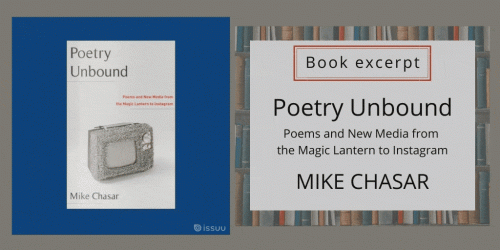Mike Chasar on Burma-Shave Ads and Modernist Poetry
MUG AND BRUSH / OLD ADAM / HAD ’EM / IS YOUR HUSBAND / LIKE ADAM, MADAM? / BURMA-SHAVE
One of the examples of the relationship between poetry and popular culture explored in Mike Chasar’s Everyday Reading: Poetry and Popular Culture in Modern America, is the very popular Burma-Shave ads (see above), which dotted American roadways in the middle part of the twentieth century.
During its run, the Burma-Shave campaign inspired such modernist poets as William Carlos Williams and Gertrude Stein as well as countless ordinary Americans, who submitted their own poems/jingles to the company for possible use. In the following excerpt Chasar describes the importance of the Burma-Shave ads as a way of understanding the role of poetry in the United States and how it resisted the high/low dichotomies which have shaped poetry criticism. (For more on the book, you can also read the book’s introduction Poetry and Popular Culture):
The Burma-Shave poems not only cultivated a poetics that foregrounded the materiality of poetic language and in doing so deferred reading but, also, like many of the new poetries of twentieth-century America, experimented with the effects of new technologies on reading practices while self-consciously engaging discourses of modernity. That is, the popularity and market effectiveness of Burma-Shave’s sales pitch depended in large part on, and succeeded in popular culture because of, the innovative thickness or ambiguity of its language rather than the transparency that we might otherwise be tempted to attribute to commercial discourses. This is the innovative spirit of advertising that attracted writers like Josephson, Stein, and no doubt others (like William Carlos Williams) whose poems are full of billboards, signs, and other aspects of early American road culture….
While the formal aspect of the Burma-Shave campaign suggests how easily linguistic innovation and literary techniques can be pressured into serving the marketplace, the campaign’s reception history illustrates how ordinary readers do not always consume commercial poetries as passively or predictably as one might think. Indeed, motorists responded with such enthusiasm to the poetry—and to the company’s invitation to participate in the campaign through jingle-writing contests—that they increasingly ignored Burma Vita’s signature product in favor of the pleasure, humor, and creative forces of reading and writing poetry. In the late 1950s and early 1960s, in fact, members of Burma-Vita’s board of directors accused the rhymes of contributing to the company’s declining market share, arguing that Burma-Vita should limit its use of jingles and begin “using prose . . . as simple, direct selling copy” to get sales back on track. These responses not only caution against our characterizing for-profit or commercially used verse as inevitably corrupted or owned by the marketplace but also suggest that readers of popular verse forms are not as easily manipulated or constrained by the culture industries as some people assume. For while Burma-Vita’s campaign proved financially successful for a time, helping the company turn a profit throughout the Great Depression, its history shows how poetry created even in the most commercial of contexts might come to resist the commodification feared by many canonical writers and critics in the twentieth century.
Burma-Shave’s jingles were unconventional by the prose- and image-heavy advertising standards of the 1920s and 1930s, but they were otherwise fully part of their age—a literary form made possible by a newly mobile American public, the new system of highways on which that public’s mobility depended, and the establishment of outdoor advertising as a legitimate (i.e., self-regulating) industry in the United States. The Outdoor Advertising Association of America formed in 1925, one year before the first Burma-Shave signs appeared and midway through the decade that James Fraser calls the “golden age of billboards.” A feeling of modernity was in the air—on radio airwaves, in the skies, and in the heights of the first skyscrapers, as well as on and along the new highways—and Burma-Vita viewed itself, its billboards, and its new shaving technologies as participating in the project of its time. “Shaving with Burma-Shave is the Modern Way of Shaving,” the company’s Advertising Copy Manual for “Burma-Shave” Road Signs reads. “Shaving soap and brush belong to the age of the shaving mug, the moustache cup, the ox-team and the beaver hat. Burma-Shave is representative of the age which has produced the safety razor, the airplane, and the radio.” Indeed, insofar as it sought to distance itself from shaving soap—a version of the product that Pound singled out in “A Few Don’ts”—Burma-Vita might even be said to have been pursuing a Poundian rhetoric into the mid-twentieth century.
If the Burma-Shave campaign was enabled by specific historical factors, its disappearance is equally historical. By the 1950s men’s beards were growing as fast as ever, but while Burma-Vita was managing (for the moment) to keep up with newer shaving technologies like aerated shaving cream and electric razors, it was struggling to meet the challenges of a new medium, television, which was drastically affecting the face of advertising, if not the face of the American man. Company president Allan Odell’s Annual Message from 1953 mentions the “saturated program of 10-second announcements on TV in Chicago” designed to plug the new “Burma-Shave Bomb,” but the company was never able, here or elsewhere, to translate its well-known poems to this (noninner) tube. The problem was not Burma-Vita’s lack of mastery of the medium; in a last-ditch effort to reclaim its market share in the 1960s, the company hired a professional agency to develop television spots, but those failed, too. The experience of reading Burma-Shave poetry—a site-specific temporal, material, and technological experience—just didn’t cross over to TV.
In the intervening years, though, what is commonly called America’s love affair with the road helped sustain conditions that were right for Burma-Vita’s poems. Even so, the campaign’s success was more accident than cool calculation. In 1926 the company founder, Clinton M. Odell, resisted his son Allan’s idea of using billboards, but in an effort to salvage what was then a failing company, he gave Allan two hundred dollars to experiment with. The signs, which did not start rhyming until 1929, worked better than either could have imagined, capturing motorists’ attention so well that Burma-Vita almost immediately began turning a profit and continued doing so during the Depression. Although the company would eventually manufacture other products (including Burma-Shave Spicy After Shave Lotion, Burma-Vita Tooth Powder, B-V Mosquito Cream, razors, and razor blades), which were marketed on the radio and in newspapers, store windows, magazines, ballparks, and buses, its shaving cream and jingles, like
MUG AND BRUSH
OLD ADAM
HAD ’EM
IS YOUR HUSBAND
LIKE ADAM, MADAM?
BURMA-SHAVE







